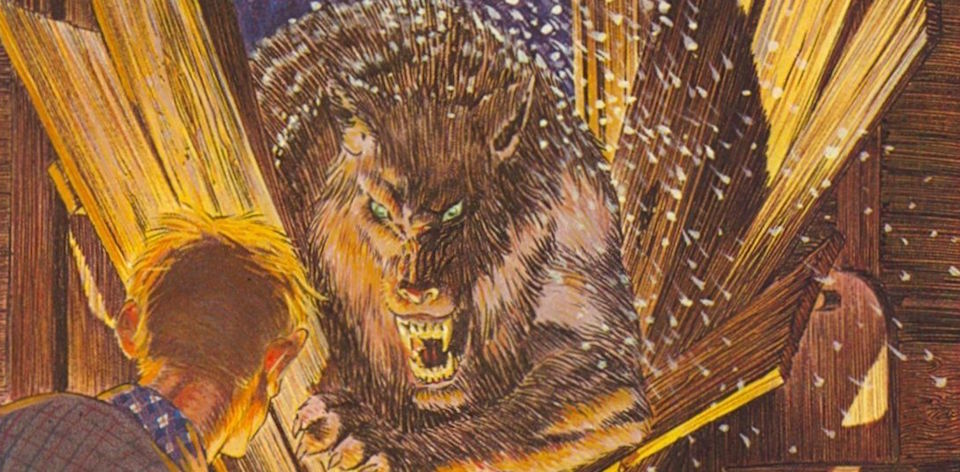Welcome back to the feature column that explores Stephen King’s books in the order they were published! (Sort of!) A calendar turned short novel, can this also be seen as King’s experimental art project? WARNING: this gets into spoiler territory.
Writing for The New York Times in 2015, Stephen King defended the reputation of prolific writers. It’s a moniker he’s certainly earned, and 1983 was the first of several years where the the author would publish three or more books. CYCLE OF THE WEREWOLF is arguably the most experimental of that year’s output.
Following the doorstop of Christine and the sublime Pet Sematary earlier in the year, King could have happily sat on his laurels. So, this short novel, clocking in at less than 130 pages including the gorgeous Bernie Wrightson illustrations, is King purely having fun in pure horror territory.
Having started its life as a calendar, King found the allotted space too limiting and expanded the vignettes into a larger piece. Each chapter tells of a werewolf attack on one of the townsfolk, slowly revealing the identity of the wolf in human clothing as the population diminishes each full moon. Like ‘Salem’s Lot, it’s just as much about the Lovecraftian tapestry of the county as it is about the attacks.
Some of the originally framework is retained, with monthly chapter headings the clearest indication of its intended origin. While the whole book can be devoured in one sitting, each of these could also be read in isolation, at least for the first few months. Yet just as the book threatens to tip over into wash-rinse-spin-repeat cycle, King injects a through-line in the form of the 10-year-old, wheelchair-bound survivor Marty Coslaw.
Some may find this traditional approach somewhat expected. After all, by this stage King had ticked off vampires, demon cars, angry dogs, and multiple psychic children. If it didn’t sit between Pet Sematary and 600+ page The Talisman (co-authored with Peter Straub), perhaps I wouldn’t think of this as a slender book. When it was released in 1983, the hardcover volume may have felt like an expensive collector’s item.
So let’s not consider this as something “lesser” for its size, especially from an author who has increasingly embraced the novella throughout his career. As someone who reads a lot of comics, I prefer to think of this as the product of an artistic collaboration between an established horror writer and the legendary artist Bernie Wrightson. Perhaps best known for co-creating Swamp Thing at DC Comics, I’ve long admired Wrightson’s detailed horror art on adaptations of Poe, Lovecraft and many other Victorian ghouls.

Wrightson’s artwork dominates the book, telling its own visual story that both compliments and sometimes overtakes the text. In addition to the stunningly rendered colour plates, each of the months opens with pencil and ink sketches that become increasingly spartan and macabre as the year progresses. I occasionally found the images distracting, as they revealed key plot points a page or two before they take place. (They was especially true of the gripping finale).
It’s funny: the 95-minute film adaptation Silver Bullet (1985), directed by Dan Attias with a screenplay written by King, may actually take longer to watch than this does to read. One has to wonder what this book could have been if King had expanded this even further. King would be beholden to his various addictions for more than half a decade after this, and this frenetic pace was almost emblematic of his output at the time.
Indeed, the ultimate reveal that Reverend Lowe – telegraphed as the monster from about April – is a figure at war with himself: he can’t control his inner demons, nor can he remember his actions when he is lupine. King more directly addressed alcoholism in ‘Salem’s Lot (with another priest) and The Shining, but it’s hard not to see parallels here. At the height of his addictions, King famously has no memory of creating his own demon dog, Cujo.
King was no less prolific in 1984, dropping another triple threat with The Talisman, the fantasy book The Eyes of the Dragon and Thinner (as Richard Bachman). For the record, he’d do it all again in 1987 and 1996. CYCLE OF THE WEREWOLF remains an interesting artefact in heart of this output, one that bares a little of King’s soul while remaining a ripping yarn.
Having read The Talisman and The Eyes of the Dragon as part of my Dark Tower journey in 2017, the next instalment of Inconstant Reader will skip straight to Thinner. While you’re here, go check out Batrock.net, where my buddy Alex Doenau is running through this Stephen King adventure with me.





